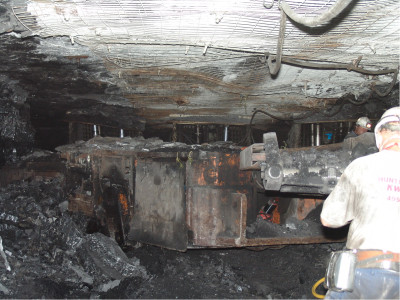THE MODERN WONGAWILLI METHOD
Modern Pillar Extraction 0 CommentThe Wongawilli system involves much larger blocks of up to 200 m wide. It consists of a 2 or 3 heading entry headings driven through the centre of the panels, splitting the panel into two smaller panels. The panel can be up to 1000 m long. Lifting of the fenders is carried out to the left and right of the split. This has been made possible with ‘the introduction of hydraulically operated Breaker Line supports (BLS)
The sequence-of extraction shows splits driven off A and B headings. The split off A heading is driven 80 m and holed into a heading being formed for ventilation purposes only. Extraction will commence at 70 m from A heading as indicated. The split from B heading is driven 75m to the heading of the panel. This roadway can also be for ventilation of the goaf area. Lifting of fenders is sequential left and right lifting and pillar A – B is split once as shown in the plan for access. All splits are at 21 m centres and the maximum width of the splits will be 5 m. Therefore, the maximum fender width will be 8m. The fenders formed by pre-splitting of the pillar A-B will be initially 16 m and only as lifting takes place from A to B; the fender of the pre-split pillar will be reduced to 8 m.
During the lifting operation, stocks are intentionally left at the back of lifts. The width of these stocks are generally small (< 1.0m) and thus offer no significant support to the roof. The size of the stocks at the end of the fender are minimum and under certain conditions, such as a large area of standing goaf or the presence of geological structures the performance of the stooks and fenders may be affected. The size of the stooks and fenders can be changed as dictated by prevailing conditions and experience of the mining officials.
The position of the BLS’s during each lifting operation are such that they are kept as close to the solid coal abutments as possible. During support movement the BLS closest to the goaf is advanced first. These positions and sequences are considered the most practical with regard to providing effective roof control.
The production and productivity of the Wongawilli system is tied up with coal cutting, support setting and coal clearance systems deployed. It is clear from Table 3 that correct combination of equipment and operational practices can lead to higher output and productivity as that shown by United, Cook and South Blackwater collieries. At United Colliery in NSW, the increased output is attributed to the deployment of continuous bridge conveying or chain haulage system with place change method of heading development and pillar extraction. At South Blackwater in Qld, three shuttle car system is used.


